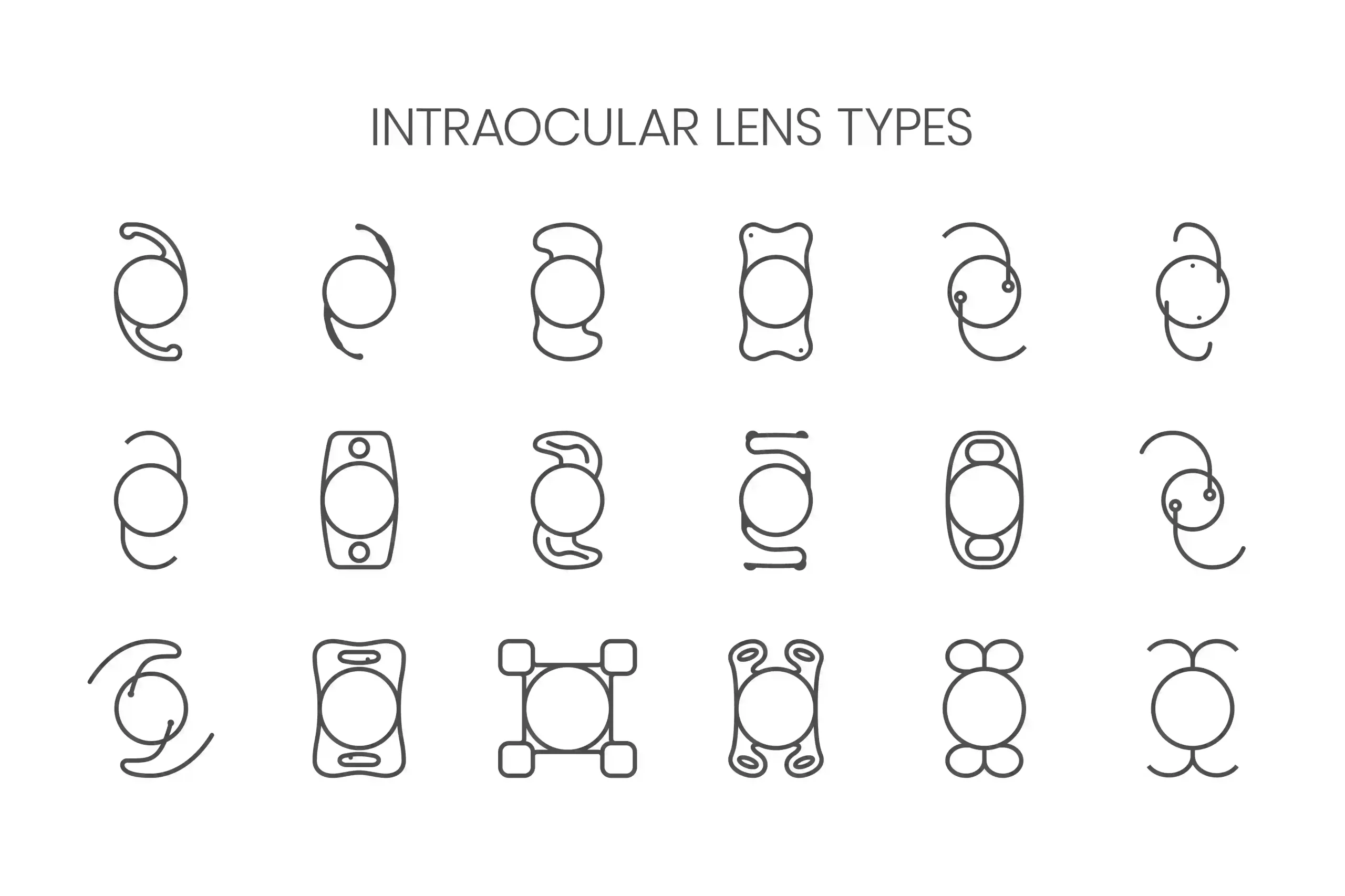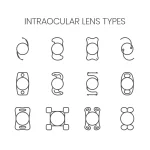Hey there! If you’ve been thinking about cataract surgery, you’re at the right place. We’re diving into the fascinating world of intraocular lenses (IOLs) and helping you identify which will be your ideal visual aid after the surgery.
Cataract surgery is one of the most common and successful surgical procedures performed worldwide. In it, the cloudy lens of the eye is removed and replaced with an artificial lens known as an intraocular lens (IOL). These lenses come in various types, each offering unique benefits. In this comprehensive blog, we will explore different types of intraocular lenses, from the traditional monofocal lens to advanced multifocal options, as well as learn the factors to consider while choosing the right one among all the types of IOL for cataract surgery. So, let’s embark on this knowledge journey!
What are Intraocular Lenses (IOLs)
Intraocular lenses are tiny yet powerful optical devices which have the ability to transform the way we see the world, enhancing our vision and quality of life. So, let’s understand how all IOL lens types work and discover the unique benefits they bring to the world of ophthalmology.
Types of IOL lens
Below are the major types of IOL Lens:
- Monofocal
Monofocal IOLs are one of the most traditional and widely used OL lens types. They offer a single focal point, which means that they provide clear vision for one specific distance – either near, intermediate, or far. Individuals who prefer a monofocal IOL often opt for clear distance vision and rely on reading glasses or other corrective measures for close-up tasks.
Advantages:
- Predictable Results: Monofocal IOLs are an excellent choice for patients who have straightforward vision needs.
- Cost-Effective: These IOLs tend to be more cost-effective compared to multifocal or premium lenses.
- Low Risk of Visual Disturbances: Monofocal IOLs have a lower risk of visual issues like halos and glare, making them suitable for night driving.
- Multifocal
As the name suggests, Multifocal lenses provide multiple focal points within a single lens. It allows individuals to see clearly at different distances, eliminating the need for glasses. These types of IOLs lenses can correct presbyopia, a condition that affects near vision as people age.
Advantages:
- Reduced Dependence on Glasses: Offer the convenience of clear vision at various distances.
- Enhanced Quality of Life: Improved quality of life due to their ability to perform a wide range of activities.
- Extended Depth-of-Focus Lens
Extended depth-of-focus IOLs are the most recent innovation in all Intraocular lens types that aim to provide continuous and seamless vision across various distances. Unlike multifocal IOLs, it does not have distinct focal points. Instead, it offers a continuous range of focus, helping patients easily achieve superb vision at varying distances.
Advantages:
- Continuous Range of Vision: Reduces the likelihood of visual disturbances associated with multifocal lenses.
- Improved Intermediate Vision: Excellent at providing clear vision for intermediate tasks, such as using a computer or reading a menu at a restaurant.
- Enhanced Night Vision: Offer better night vision compared to some multifocal options.
- Light-Adjustable Lens
The light-adjustable lens is the most innovative development in the field of Intraocular lens types. It can be customized and fine-tuned after cataract surgery to reshape the lens, optimizing the patient’s vision as required.
Advantages:
- Personalized Vision: It can be adjusted and personalized to meet each patient’s unique visual requirements.
- Reduced Need for Multiple Surgeries: It can be modified after the initial cataract surgery, eliminating the need for additional surgeries to address changing vision needs.
- High Precision: High level of precision in correcting vision, potentially leading to excellent outcomes.
4. Toric Intraocular Lens
Toric IOLs are specifically designed to address astigmatism. These type of IOLs lenses have a toric shape, which allows them to work effectively for the irregular curvature of the cornea in astigmatic eyes.
Advantages:
- Astigmatism Correction: Eliminates astigmatism, improving the overall quality of vision.
- Reduced Need for Glasses: Reduces dependence on glasses for distance vision.
- Improved Contrast Sensitivity: Enhances contrast sensitivity, leading to sharper and clearer vision, especially in low-light conditions.
- Accommodating IOL Lens
Accommodating IOLs are IOL lens options designed to enhance the natural flexibility of the eye’s crystalline lens. These lenses can adjust their shape in response to the eye’s focusing muscles, providing a range of clear vision at varying distances.
Advantages:
- Near-Natural Vision: Provides a more natural vision experience.
- Reduced Dependence on Glasses: Offer improved near and intermediate vision.
- Less Risk of Visual Disturbances: Lower risk of visual disturbances compared to multifocal IOLs.
- Custom and Enhanced Intraocular Lens
Custom and enhanced IOLs are designed to cater to patients with specific vision needs or unique anatomical considerations. These IOL lens types can be tailored to correct a wide range of refractive errors and can be combined with other advanced technologies.
Advantages:
- Individualized Solutions: It can be customized to address an array of visual imperfections.
- Comprehensive Correction: It addresses not only cataracts but also other refractive errors like myopia, hyperopia, and presbyopia.
- Enhanced Visual Outcomes: Offers excellent and often superior visual outcomes.
A Comparative Table for All Intraocular Lens Types
| Characteristic | Monofocal IOL | Multifocal IOL | Toric IOL | Accommodating IOL |
| VisionCorrection | Single focalpoint (usuallydistance vision) | Multiple focalpoints (distanceand near) | Single focal point for astigmatism | Single focaL Point (Usually distance vision) |
| Near Vision | Requiresreading glasses | Reduced dependency onreading glasses | Requiresreading glasses | Reduced dependency on reading glasses |
| DistanceVision | Clear, but mayrequire glassesfor near vision | Clear fordistance, butmay experiencehalos or glare | Clear, but mayrequire glassesfor near vision | Clear, but may require glasses for near vision |
| AstigmatismCorrection | No | No | Yes | No |
| Quality ofVision | Excellent fordistance vision | Good for bothnear anddistance vision | Excellent fordistance visionand astigmatism | Good for both distance vision, but may have some halos or glare |
| Adjustability | Not adjustable | Not adjustable | Not adjustable | Limited adjustability |
| TypicalCandidacy | Patients whoprioritizedistance vision | Patients whodesire reduceddependence onglasses | Patients withastigmatism | Patience seeking less dependence on glasses |
| SurgicalComplexity | Straightforward procedure | Straightforward procedure | Straightforward procedure | Straightforward procedure |
| Cost | Typically lower | Typically higher | Typically higher | Typically higher |
Factors to Consider in Choosing an IOL for Cataract Surgery
Selecting the right type of IOL lens for cataract surgery involves careful consideration of several factors, including:
- Visual Needs: The type of IOL you choose must be chosen after considering your lifestyle and daily activities. For example, if you read frequently or work on a computer, a multifocal or EDOF lens may be a good choice. If you engage in activities that demand sharp distance vision or have a cylindrical power, a toric IOL would work well.
- Existing Refractive Errors: Some IOLs are better suited to correct specific refractive issues, such as myopia, hyperopia, and astigmatism.
- Lifestyle and Hobbies: Discuss your hobbies and interests with your surgeon. Depending upon it, he will suggest the best suited iol lens types.
- Budget: The cost of the IOL and cataract surgery can vary depending on the type of lens you choose. So, please consider accordingly.
- Tolerance for Visual Disturbances: Some premium IOLs, like multifocal lenses, may introduce mild visual disturbances. So, assess your tolerance for these disturbances and discuss them with your surgeon. You may visit Centre For Sight and find world-class surgeons there. Book an appointment.
- Health and Medical Considerations: You as well as your ophthalmologist should consider any pre-existing conditions or medications that could affect the outcome of cataract surgery.
Conclusion
Cataract surgery, when done with the selection of the right type of intraocular lens, can significantly improve the vision and quality of life. The diverse range of Intraocular Lens available today give individuals complete liberty to choose Intraocular lens types that align well with their specific visual needs and lifestyle preferences. Ultimately, the goal is to help you regain clear and comfortable vision, whether for distance, reading, or everything in between. We, at Centre For Sight are renowned for performing successful cataract surgery. Not only that, we are the only eye care hospital in North India to have every eye care facility under one roof, be it Contoura Vision, ICL surgery, Refractive surgery, etc. So, visit us and get crystal clear vision.
FAQs
Can I upgrade to a different type of IOL after cataract surgery if my vision needs to change?
Yes, it is possible to upgrade to a different type of IOL (Intraocular Lens) after cataract surgery if your vision needs change. This procedure is known as IOL exchange and can help address evolving visual needs or preferences.
Are accommodating IOLs suitable for everyone, and how do they work?
Accommodating intraocular lenses (IOLs) are not suitable for everyone as they work by changing shape to adjust focus like the natural eye’s crystalline lens.
How do I know which type of IOL is best for my vision needs?
Consult with an eye care professional. He/she will assess your unique eye characteristics, discuss your visual requirements, and recommend the most suitable intraocular lens.





